
Choosing an aesthetic for your business can be overwhelming, and with so many restaurant design and decor ideas out there, it’s hard to know where to begin. As you open your new restaurant, you’ll have a lot of decisions to make: from choosing your restaurant POS to selecting the best napkins and everything in-between.
Even if you’re a seasoned restaurant owner, this article can help you figure out ways to improve your interior design in order to boost your restaurant in the eyes of existing and new customers.
We’ve compiled a list of 21 restaurant design ideas, along with tips from HGTV’s Taniya Nayak to help you decide which look is right for your menu, location, and target customers.
21 restaurant design and decor ideas
- Typography
- Support local artists
- Murals and wall art
- Go green
- Open up the space
- Pick a theme
- Modern minimalism
- Embrace the classics
- Community-centered design
- Location-based design
- Be mindful of lighting
- Functionality is key
- Consider sustainability
- Integrate technology
- Make your space adaptable
- Think of health and safety
- Importance of accessibility
- Acoustic design
- Creative seating
- Spruce up your outdoor space
- Incorporate cultural elements
Get more customers through your doors
Designing your restaurant is just the first step. Find out how to get more guests in the door with our free Restaurant Marketing Guide.
1. Typography
When done right, incorporating typography into your decor is often a hit. Bold graphics, marquee letters, diagrams and charts are all fun (and informative) ways to add details to your design scheme. Old-school neon signs are a big hit right now, too—try getting one custom-made with a quote or phrase that reflects the vibe of your restaurant.
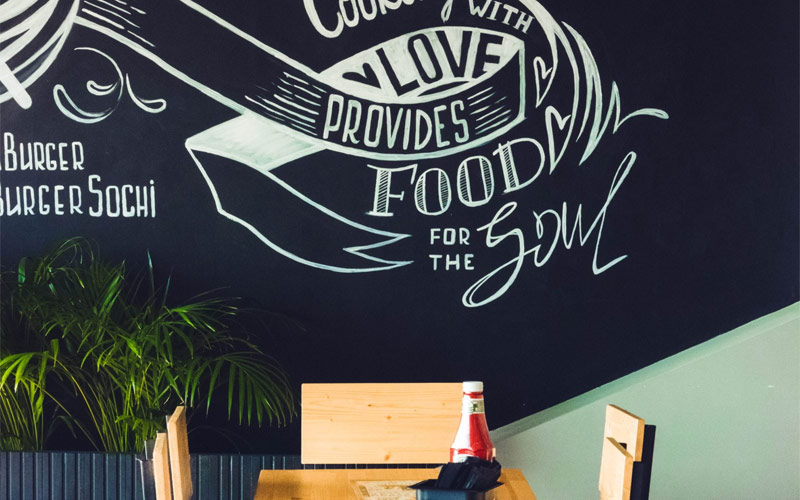
2. Support local artists
If you have a large, open wall space that you want to design on a budget, reach out to local talent for help. By creating a gallery-style wall featuring a new artist or group of artists either monthly or quarterly, you get a rotating collection of unique decor, and local artists get their work seen and potentially sold.
3. Murals and wall art
Aside from a gallery wall, another excellent option for showcasing local talent is to hire an artist to create a mural or graffiti-style wall art. Creating an Instagram-worthy backdrop encourages guests to snap photos and selfies in your venue, giving you added publicity in the form of user-generated content. No room inside for mural-sized art? Put a mural on your building’s exterior instead!
Lightspeed customer Boukan welcomes diners with art walls, adding vibrancy and pops of color to the airy space. The art contrasts well with its dark interior, giving guests more to admire than just its delicious Haitian-fusion cuisine.

4. Go green
Decorate your space with lots of greenery by including indoor plants in your venue decor. Not only are plants beautiful and relaxing, but many help purify the air. They also make a visual connection for guests about the freshness of your ingredients.
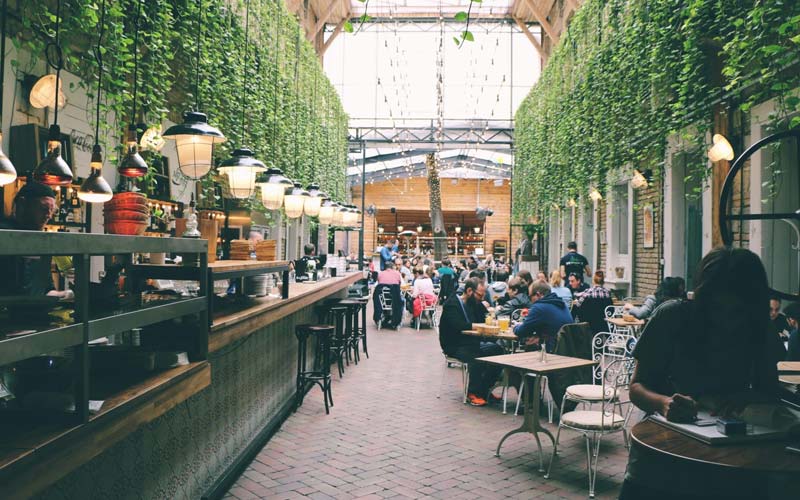
5. Open up the space
Make the kitchen part of the decor, especially if you have a unique focal point like a wood-burning oven for pizza. If opening up the kitchen isn’t a possibility, consider an exposed wine cellar, whiskey tunnel, or another unique space to give guests a glimpse of the back of house (BOH). Inviting people to get up close to your products sparks their interest and gets them talking. The more they learn, the more they tend to spend.
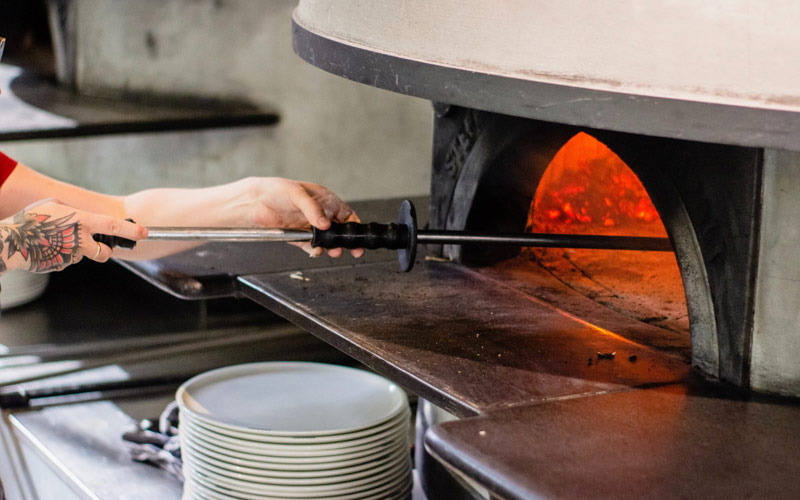
6. Pick a theme
Themed restaurants have a reputation for being a bit overboard, but they don’t have to be. If you think a theme will work well for your restaurant design, try to pick one that isn’t too trendy as it will look dated in a few years. Instead, pick something that reflects your menu or brand and incorporate your theme in a modern way, like Ladybird’s 1970s-style summer camp theme.
7. Modern minimalism
If you’re looking for a less-is-more vibe, go with a minimalist look. Think clean lines, natural materials and a simple color scheme. Remember that a simple approach can sometimes be more difficult because every little detail matters and will be noticed.
Lightspeed customer Miriam is a great example of modern minimalism. Their balanced approach to design creates a welcoming and contemporary atmosphere for customers.

8. Embrace the classics
Certain looks are classics for a reason, as long as it works with your restaurant’s menu. French bistros, fifties-style diners, or a classic pizzeria-inspired look can all lend a sense of nostalgia while still having a modern twist.
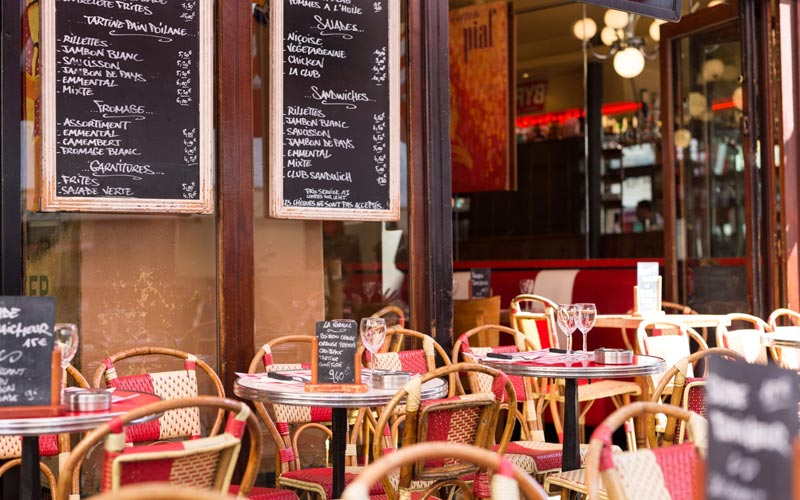
9. Community-centered design
Food is a great equalizer, and restaurants can bring a community together. To create a community-centered experience in your restaurant, try adding a communal table, removing TVs, or offering board games for guests to play while they wait.
Take Chicago restaurant and Lightspeed customer Recess, which boasts the city’s largest patio. They’ve created a space that encourages community and socialization, with plenty of food options and a mix of indoor and outdoor activities for guests to enjoy.
It doesn’t hurt that their patio is in a great location with equally great views.
10. Location-based design
Sometimes your decor will decide itself. A seafood restaurant on the water will call for blues and whites, light wood, and tasteful nautical touches, while a BBQ joint in Texas is going to set an entirely different set of expectations. Take a look around you and think about what customers will expect when walking into your restaurant.
Lightspeed hotel restaurant Terrace Bay exemplifies this decor approach. Customers walk into an open space with plenty of light overlooking the bay, and their simple design choices allow the natural beauty to shine as its own design element.
11. Be mindful of lighting
Good lighting creates ambiance for your guests. Take the time to think about what type of environment you want to create and how you want your guests to feel in your restaurant. Aside from the feel of the restaurant, other things to consider when choosing your lighting include energy efficiency, staff safety and whether you want customers to get a good shot of their plate for social media.
Lighting serves various purposes. Ambient lighting creates a welcoming atmosphere, while task lighting illuminates specific areas like tables or bars for practical purposes. Dimmable fixtures allow for adjustable brightness to accommodate changing needs throughout the day.
Additionally, decorative lighting elements, like chandeliers or pendant lights, serve as focal points and contribute to the overall aesthetic. By balancing mood and functionality, restaurants can create dynamic lighting designs that enhance the dining experience.
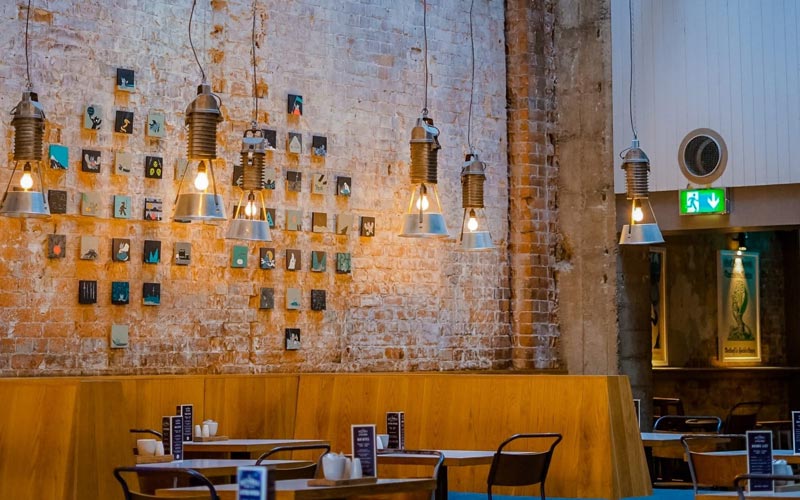
12. Functionality is key
Function can be far less fun to implement than design, but a well-functioning restaurant can make a significant impact on your bottom line. Hire a professional designer to plan your layout and maximize function. A small space doesn’t necessarily need to feel crowded or cramped!
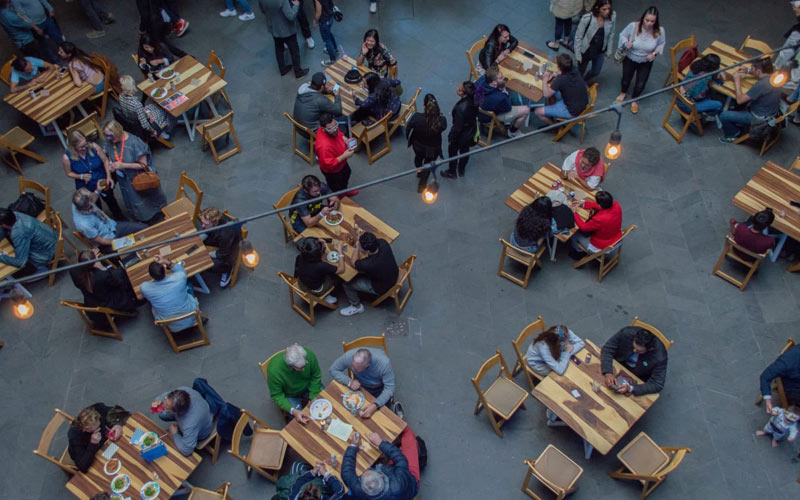
13. Consider sustainability
Sustainable design is crucial in today’s environmentally conscious world. Incorporate recycled materials, such as reclaimed wood or recycled glass to reduce waste and lower the carbon footprint of your restaurant.
Additionally, sourcing materials from sustainable suppliers ensures ethical practices and supports eco-friendly initiatives. From furniture made of reclaimed materials to energy-efficient appliances, every aspect of the restaurant’s design can contribute to a more sustainable future.
14. Integrate technology
Integrating technology into restaurant design can enhance the customer experience as well as operational efficiency.
For instance, digital menus not only reduce paper waste but also allow for easy updates and customization. Smart lighting systems adjust brightness and color to create the desired ambiance while saving energy.
Tableside tablets, like Lightspeed Tableside, streamline ordering and payment processing, which improves service speed and accuracy. Embracing technology modernizes your restaurant, reduces visual clutter and elevates the overall dining experience.

15. Make your space adaptable
Consider making your space adaptable so you can accommodate various events and dining preferences. Movable partitions or furniture allow for flexible layout changes, catering to different group sizes or private events. Transformable seating arrangements, such as modular booths or collapsible tables, maximize space utilization without compromising comfort.
By creating versatile spaces, you can adapt to changing needs and enhance your restaurant’s appeal to a diverse clientele.
16. Incorporate health and safety practices
It’s important to consider health and safety in every aspect of your restaurant, including design.
Air purification systems improve indoor air quality, which ensures a safer dining environment for diners and staff. Easy-to-clean surfaces, such as antimicrobial coatings or non-porous materials, minimize the risk of germ transmission.
By prioritizing both functionality and aesthetics, restaurants can create spaces that prioritize the well-being of everyone.
17. Make your interior accessible
With health and safety also comes accessibility. Designing accessible spaces ensures that everyone, regardless of ability or age, can enjoy the restaurant experience. Implement features such as ramps, wide doorways, and accessible restrooms.
Provide seating options with varying heights and styles to accommodate individuals with different needs and preferences. Clear signage and tactile indicators aid navigation for those with visual impairments.
By prioritizing accessibility, you demonstrate your commitment to serving all patrons.
18. Acoustic design
Have you ever tried having a conversation in a restaurant, but found it much too loud to hear the other person speak?
Although you may not immediately think of sound when you’re designing your restaurant, effective acoustic design is essential. Select materials carefully to reduce noise levels. Even strategic layout planning such as table positioning can help control sound diffusion and allow people to carry out private conversations.
These small adjustments can improve ambiance and customer satisfaction.
19. Get creative with seating
Add personality and functionality to your space with creative seating.
From cozy booth designs to communal tables, seating arrangements can boost social interaction and accommodate varying group sizes. You can even incorporate themed seating, such as swings or pods, to create memorable dining experiences that align with your restaurant’s brand.
Lightspeed customer BRGR BRGR offers a mix of seating arrangements, from booths to communal tables, with plenty of space for customers to sit.
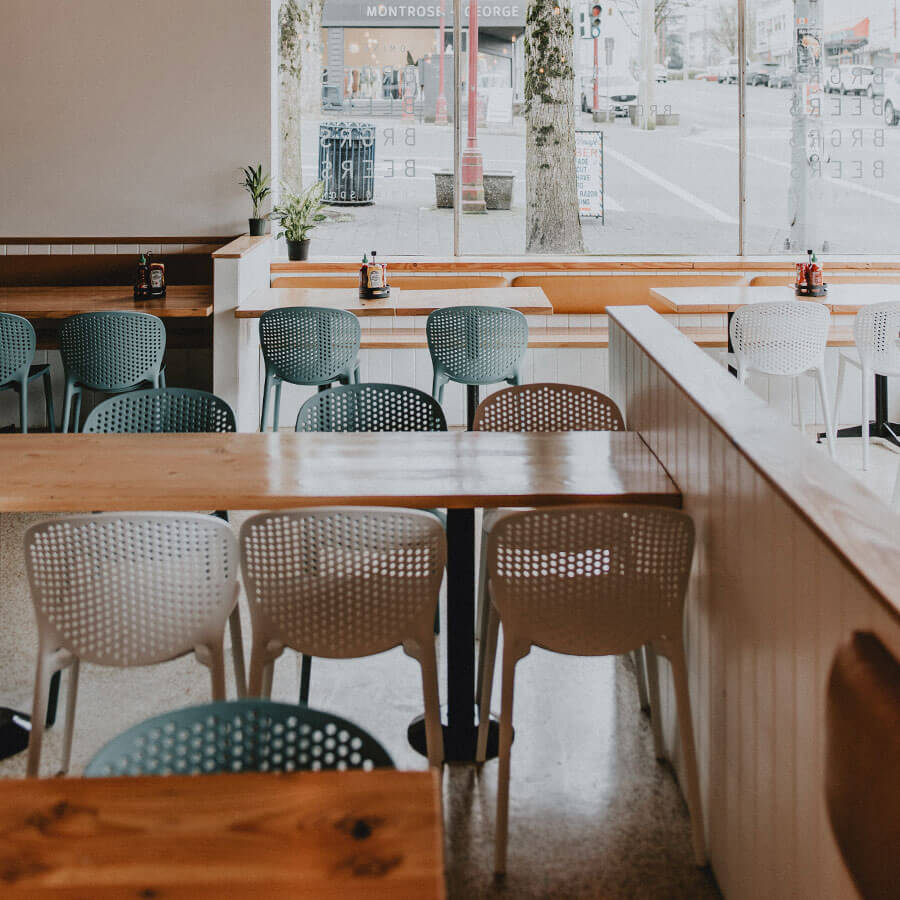
20. Outdoor dining
Outdoor dining areas provide a refreshing alternative to indoor dining. Thoughtful design elements, such as comfortable seating, shades and weather-resistant materials, ensure a pleasant experience for guests in any season.
You can incorporate greenery, like vertical gardens or potted plants, to enhance the ambiance and promote relaxation.
By maximizing the potential of outdoor spaces, restaurants can attract diners seeking al fresco experiences and capitalize on the growing trend of outdoor dining.
21. Incorporate cultural or historical elements
Add depth and authenticity to the space by implementing relevant historical or cultural themes.
From architectural details to decor accents, references to local heritage or historical significance create a sense of place and identity. Artwork, artifacts or traditional motifs celebrate cultural diversity and invite patrons to explore and learn.
By weaving cultural and historical narratives into the design, restaurants can create immersive experiences that resonate with guests and foster connections to the community.
Restaurant design tips from HGTV’s Taniya Nayak
From acoustics so bad you wish earplugs were on the menu to clichéd decor, hackneyed—or just plain bad—restaurant design can leave a bad taste in a guest’s mouth. When it comes to dining out, the ambience can be as important as the cuisine, and unpalatable design should never compromise the experience.
We tapped award-winning Boston-based designer Taniya Nayak—who has lent her refined eye to hub hotspots like Lower Mills Tavern and starred on the Food Network’s Restaurant: Impossible along with several HGTV shows—to school us on some of her go-to pro tips for intelligent restaurant design.
Take a seat
“One of the best tips I can offer is to sit in every seat [in the restaurant]. Sometimes this needs to be done mentally as you work off of your drawings. Be sure that every guest in every seat is looking at something nice!”
Bright lights, big problem
“Bright lights are for cafeterias. Ambient lighting is everything when it comes to a proper dining experience. Set the mood with lighting that is dimmable and adjust it accordingly throughout the day. Leave the fluorescent lights in the kitchen.”
Don’t hide the host
“I often see a host stand set up in an area where they cannot see the guests—or the guests cannot see them—as they enter. A warm hello and welcome greeting is the guests’ very first impression of the place. This should never be overlooked or deemed unimportant.”
Consider sound and materials
“Tile and wood look great together, but they often send sound waves bouncing off the walls. Be sure to incorporate some type of soft seating (upholstered banquettes, bar stools or dining chairs), acoustical ceiling tiles, or even soft drapery to help absorb the noise. Plus, it looks great!”
Read between the lines
“If you’re designing a restaurant, don’t forget to read the menu or chat with the chef! The design [of the space] should always have a tie to the food that is being served. Let’s face it: eating sushi in a country kitchen could seem a little odd.”
Let history repeat itself
“I always try to grab hold of a piece of history of that space or the area. Locals and tourists always seem to appreciate a good story. My husband and I just opened up Yellow Door Taqueria in Dorchester, Massachusetts. It used to be an iconic antique store for over 20 years—a favorite corner shop in the neighborhood. In coming up with the design concept, we wanted to hold on to the history by designing a taqueria that has the look and feel of an old antique shop. The place turned out great, and, more importantly, the guests seem to really appreciate that we went in that direction.”
Don’t forget where you came from
“Start out with a really strong concept board. Sometimes things shift and get sidetracked during the process because some fabrics are no longer available or the budget constraints require finding alternatives. It is always good to check back to the original intent.”
Take your restaurant to the next level
Designing and starting a restaurant is a big undertaking. Luckily, there’s software that can make your day-to-day operations much easier and efficient.
Chat with one of our restaurant experts to learn how Lightspeed can give you the tools your restaurant needs to thrive and grow.

News you care about. Tips you can use.
Everything your business needs to grow, delivered straight to your inbox.



